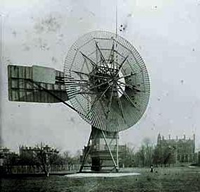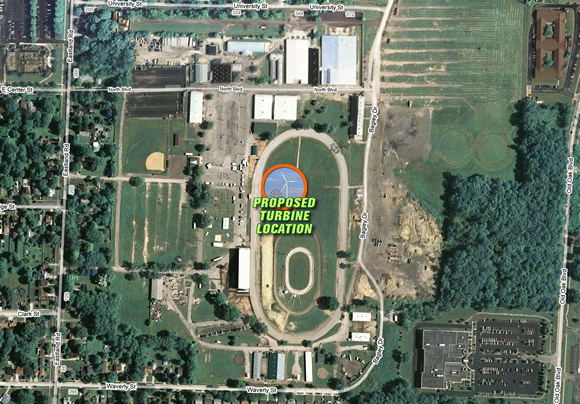|
Why Wind?
"If you surrendered to the air,
you could ride it."
--Toni Morrison
Annually, a single wind turbine can generate enough electricity to power nearly 600 homes (1.8 MW [Megawatts], or 5.2 million KWh [Kilowatts-hours]). Though wind turbine technology is not yet capable of producing energy as cost effectively as nuclear or coal, the reasons to pursue wind harvesting technology are myriad and obvious: Wind power is clean, renewable, and plentiful.
|
What's Watt?
Watt (W) - electricity-generating capacity
1 megawatt (MW, 1 million watts) of wind power can produce 2.4 - 3 million kilowatt-hours of electricity in one year.
Kilowatt-hour (kWh) - one kilowatt (kW, 1,000 watts) of electricity generated or consumed in one hour
|
WHAT DOES THIS MEAN FOR THE FAIRGROUNDS?
FAIRGROUNDS WIND TURBINE ELECTRICITY
Fairgrounds consumption of electricity:
675,000 kwh/ year @ 11.0 c/kwh
(= $74,250 /yr)
Wind Turbine Projected Generation:
@ 11.0 mph avg wind speed & 50m tower,
500 kw turbine:
NEG Vestas V-39 600/48: 713,000 kwh/yr
(= 100+% of usage)
(or Bonus 600)
Electrical Characteristics:
Supplier: First Energy
Transformer: 1500kvA, 13.2 kv/2400 v, 3 ph
Spare Capacity: 500 kvA (confirmation in progress)
Net Metering: Credit will be for “Generation” charge only (approx 50% of total billing). Also, only Monthly balancing per current rules; much better economics with Annual balancing.
GLOBAL WARMING & THE HEALTH HAZARDS POSED BY NON-RENEWABLES
Did You Know..?

The first wind turbine ever developed for the purposese of generating electricty was designed by Clevelander, Charles F. Brush in 1887. With 144 25ft rotor blades, it was also the largest turbine ever built for any purpose.
|
Unlike coal, the production of wind power doesn't pollute the atmosphere with dangerous compounds such as CO2 and nitrogen oxides. These greenhouse gases have long been associated with global warming, which as a phenomena, has had a cascading effect, from the melting of the polar ice caps, to the expansion of the oceans, alteration of weather patterns and bird migrations, a marked increase in the strength and number of ocean bourne storm systems, and the threat posed to coastal regions like Florida and Venice, and island nations such as Figi.
The catastrophic failure of a wind turbine, though unfortunate, could never produce the kind of human misery and environmental ruin witnessed at Chernobyl, nor the many environmental disasters and health hazards associated with coal mining--a practice which involves explosive mountain top decapitation, and the depositing of toxic coal sludge into impoundments which commonly poison drinking water, and have even been known to escape and flood low-lying towns in KY, West Virginia, and elsewhere. Additionally, unlike oil, coal and natural gas, there is an infinite supply of wind, available to all on the planet--even in those places as yet unserved by the current power grid. That said, it's hard to fathom that wind, solar, biomass, and geothermal taken together comprise only 5% of all energy produced in the U.S., with coal at 52%, nuclear at 20%, natural gas at 16%, and hydropower at 7%. Recognizing this, the U.S. has set as a goal that by 2030 our nation will have elevated our wind power production to a level which will satisfy 20% of our 3.6 trillion Kwh per year appetite for power.

NATIONAL SECURITY IMPLICATIONS
As the global population has risen, so too has demand for non-renewable energy. This increase in demand has driven up prices, and the increase in prices has effected the stability of economies across the globe. As such non-renewable resources dwindle, the likelihood of armed confrontations to lay claim to them increases, as does the need to spend vast sums of money to transport and protect the lines of transport for such energy sources. With all that said... why not start now in developing and enhancing the kind of technologies that can ween us from our addiction to non-renewable energy sources... sources which pose risks to our collective health, economy, environment, and national security?
TILTING AT TURBINES
Well, truth be told, there is one credible argument against wind power. Though valid, it can hardly be said to outweigh the merits of turbines. The argument is that if there's limited to no wind, it's impossible to maintain continuous power, as fluctuations in wind speeds invariably effect the amount of power generated. For this reason, wind driven power generators rely on small amounts of non-renewable energy to keep the currents flowing on that windless night. Though some would play this up to be a major drawback, it is at most a minor deficiency. Cutting funding to turbines for this reason would be akin to the Browns cutting Shaun Rogers because he occassionally needs a little help from an oxygen tank. The amount of unclean energy used to bolster a wind system is miniscule compared to the amount of clean energy generated, so the cost benefit analysis tilts firmly in the direction of pursuing wind technology, and we're excited to be doing just that at the Cuyahoga County Fairgrounds.
|



